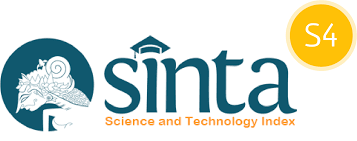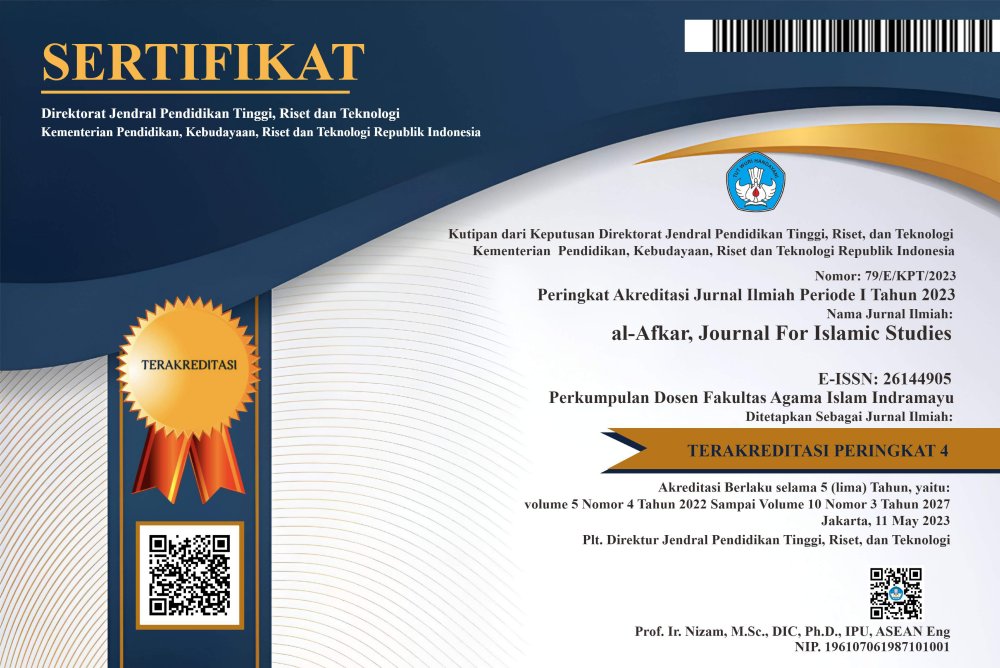Contrastive Analysis of Phonology (Sounds, Speech, Stress, and Intonation) of Arabic and Indonesian Languages
DOI:
https://doi.org/10.31943/afkarjournal.v7i3.1030Keywords:
Contrastive Analysis, Phonology, Arabic, IndonesianAbstract
Phonology has a crucial role in the early stages of learning both native and foreign languages. This research aimed to analyze the phonological differences between Arabic and Indonesian, focusing on aspects such as sound systems, pronunciation, stress, and intonation. This study was classified as a literature review. The method employed was a descriptive contrastive analysis, comparing contrasting differences in Arabic and Indonesian through a pedagogical linguistic approach. The results showed that the vowel sounds in Arabic consist of fathah, fathah thowilah, kasrah, kasrah thowilah, dhommah, dhommah and thowilah which significantly impact the meaning of the language. On the other hand, Indonesian vowel sounds /i/, /u/, /e/, /ә/, /o/, and /a/ did not influence meaning and tended to remain consistent in their speech functions. Regarding stress and intonation, Indonesian utilized these elements to differentiate meaning when spoken with flat, high, and low tones in delivering news or interrogative sentences. In contrast, Arabic stress and intonation patterns were based on the position of consonants, syllables, and the length of vowels.
Downloads
References
Akhyaruddin dkk, Bahan Ajar Fonologi Bahasa Indonesia, Jambi : Komunitas Gemulun Indonesia, 2020.
Al- Khuli, Muhammad Ali, A Dictionary Of Theoritical Linguistic. Beirut: Librarie Du Liban, 1982. 306. Dalam Hanif Fatoni, Pembentukan Kata Dalam Bahasa Arab (Analisis Morfologi “K-T-B”), Jurnal At-Ta’dib Vol. 8, No. 1, Juni, 2013.
Ali, Mohammed Ali, Haider Ibrahim Khalil, and Roza Salah Hasan, “Phonetic Interference In English And Arabic Languages,” Journal of Positive School Psychology 6, no. 9 2022.
Al-Khouli, Muhammad Ali, Mu’jam Ilmu Al-Ashwat, Riyadh: Universitas Riyadh. Cet , 1982.
Chaer, Abdul dan Leonie Agustina. Sosiolinguistik: Perkenalan Awal, (Jakarta: Rineka Cipta, 1995), 82. Dalam Rai Bagus Triadi dan Ratna Juwitasari Emha. Fonologi Bahasa Indonesia, Banten: UNPAM Press, 2021.
Chaer, Abdul, Fonologi Bahasa Indonesia, (Jakarta: PT Rineka Cipta, 2015), 1. Dalam Anin Asnidar dan Junaid, “Efektivitas Penggunaan Media Video dalam Pembelajaran Fonologi Bahasa Indonesia”, Jurnal Onoma: Pendidikan, Bahasa dan Sastra, Vol. 8, No. 1, 2022.
Ellis, R. 1986.Understanding Second Language Acquisition. Oxford: Oxford University Press.
Gani, Saida, Berti Arsyad, Kajian Teoritis Struktur Internal Bahasa (Fonologi, Morfologi, Sintaksis, dan Semantik) ‘A Jamiy, Jurnal Bahasa dan Sastra Arab Volume 07, No. 1, Juni 2018.
Ibrahim, Anis, Al-Ashwat Al-Arabiy, Maktabah Anglo: Mesir, 1971.
Jinniy, Ibn, Abu al-Fatah Usman. Sir Shina:’ah al I’rab. Tahqiq: Muhammad Hasan Muhammad Hasan. Beirut-Lebanon: Dar Kutub al-Ilmiyah, 2012.
Lafamane, F., Fonologi (Sejarah Fonologi, Fonetik, Fonemik), Osfpreprints, 2020, Doi: 10.31219/Osfio/Snmfh.
Marsono. Fonetik. Yogyakarta: Gadjah Mada University Press, 2016.
Marsono. Fonetik. Yogyakarta: Gadjah Mada University Press, 2016.
Mustafa, “Bahasa Arab Diantara Rumpun Bahasa Sem it ,Al Ibrah: Journal of Arabic LanguageEducation2,no.1,2019http://ejournal.iainpalopo.ac.id/index.php/ibrah/article/view/1208.
Mustafa, “Bahasa Arab Diantara Rumpun Bahasa Sem it ,Al Ibrah: Journal of Arabic LanguageEducation2,no.1,2019http://ejournal.iainpalopo.ac.id/index.php/ibrah/article/view/1208.
Rai, Bagus Triadi dan Ratna Juwitasari Emha. Fonologi Bahasa Indonesia, Banten: UNPAM Press, 2021.
Richards, Jack, et al. 1989.Longman Dictionary of Applied Linguistics. London: Longman.
Rifa, Rafkahanun, “Analisis Kesalahan Fonologis dalam Keterampilan Berbicara Pembelajar BIPA di Pusat Studi Indonesia Ismailia Mesir”, Madah: Jurnal Bahasa dan Sastra, Vol. 12, No. 1, April 2021.
Separno. 2002. Dasar-dasar Linguistik Umum. Yogyakarta: Tiara Wacana.
Setyaningsing, Yuliana dan Kunjana Rahardi. Fonologi Bahasa Indonesia Mengkaji Tata Bunyi dalam Perspektif Linguistik Edukatif, Yogyakarta: USD, 2014.
Singgih Kuswardono, Ahmad Miftahuddin, Kajian Bunyi Bahasa Dalam Tradisi Arab, Prosiding Konferensi Nasional Bahasa Arab IV, malang 06 oktober 2018 h.478.
Tamam Hasan, Al-Lughah baina al- mi’yariyah wa al-Washfiyah, Mesir: Alimulkitab, 2000.
Wahab, Rosyidi Abdul , “Penerapan Pola Nabr Dan Tanghim Dalam Maharah Al Kalam Mahasiswa Indonesia,” Lingua: Jurnal Ilmu Bahasa dan Sastra 11, no. 1, 1 Juli 2016 46–47, https://doi.org/10.18860/ling.v11i1.3438.
Wahab, Rosyidi Abdul, Mamlu’atul Ni’mah, Memahami Konsep Dasar Pembelajaran Bahasa Arab, Malang: UIN Maliki Press, 2011.
Wahib, Dariyadi Moch, Bunyi Vokal Dalam Aksara Arab” https://arabiyatuna.com/bunyi-vokal-dalam-bahasa-arab/, januari 17, 2018 , di akses desember 03, 2023,
Wahya and Suhaila Arong, “Korespondensi Fonemis Enam Kata Kerabat Bahasa Indonesia, Bahasa Melayu Kelantan, bahasa melayu Patani, dan Bahasa Sunda,” Metahumaniora10,no.2,2020https://doi.org/10.24198/metahumaniora.v10i2.27523.
Downloads
Published
How to Cite
Issue
Section
License
Copyright (c) 2024 Habiburrahman, Kurnia Wahyuni, Muhammad Mugni Assapari

This work is licensed under a Creative Commons Attribution 4.0 International License.



















